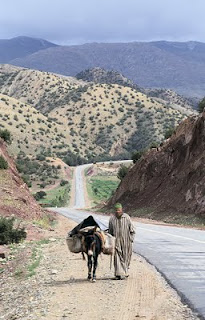-
Missives From Marrakech: Enter the Environment
›October 2, 2009 // By Gib Clarke
“Contraception is the cheapest way to combat climate change,” read the headline of The Telegraph in mid-September, announcing the release of “Fewer Emitters, Lower Emissions, Less Cost,”a study from the Optimum Population Trust (OPT) and the London School of Economics (LSE). Similar stories appeared in newspapers around the world.
Though there has been near-universal agreement that the OPT-LSE paper oversimplifies the link between demography and climate change, the buzz among the family planning and environment communities has continued during the IUSSP conference in Marrakech. Perhaps this is because demographers are not used to appearing in the press except when discussing census results. More likely it is the timing of the report, with the Copenhagen conference on climate change coming in December.The buzz hit a peak on Thursday at the IUSSP, with a plenary presentation examining the links. Wolfgang Lutz jumped right in, noting that it’s not as simple as the OPT-LSE study makes it. Population growth is important, but size is not the only thing that matters; other aspects such as age distribution, household structures, and levels of urbanization come into play as well.
In addition, between population size and climate change lie a number of intermediary factors, such as consumption levels, technology improvements, and greenhouse gas (GHG) emissions. Lutz argued that demography has a unique contribution to make to the climate discussion, for no other discipline understands the composition of different populations in different places both now and in the future. Therefore, demographers should explain how different groups will contribute to climate change, and how they will suffer the consequences, so that adaptive capacities can be strengthened and social programs can fill the gaps.
Leiwen Jiang described research conducted by some of the giants in climate and demography: National Center for Atmospheric Research, International Institute for Applied Systems Analysis, and Population Action International. Their work uses a “PET” model – Population, Environment, and Technology – which looks at how the PET elements impact four critical predictors of GHG emissions: consumption, energy use, labor, and savings. A forthcoming paper by this group will delineate the complete findings, including the potential for GHG “savings” brought by decreases in fertility and thus reduced population growth, as well as the added GHG due to future urbanization.
Susana Adamo took a step back to show the audience the view from 30,000 feet – literally, with maps demonstrating that population density is highest in areas most vulnerable to impacts of climate change, such as sea-level rises, droughts, floods, and other severe weather events.
Unfortunately, one of the stars of this research, Brian O’Neill, was unable to attend, due to health reasons. His research, to be published soon, is highly anticipated, and should add additional quantitative fuel to the fire.
Not Just Climate
Environmental links with population and demographic factors have also factored in other parts of this “demography” conference. A host of sessions, many organized by the Population-Environment Research Network, have explored linkages between population growth, migration, and urbanization on the demographic side; and deforestation, natural resource management, and environmental degradation on the environmental side. Questions concerning these and other environmental factors have surfaced at panels exclusively dedicated to other topics such as family planning. Some sessions examined how population and environment concerns can be jointly addressed.
It is encouraging to see demographers and reproductive health specialists taking climate and environmental factors so seriously. The response from the environmental community has been mixed, with some interest in population issues, but also some opposition from the climate community to including discussions of family planning in an already controversial topic. At a similarly large gathering of environmentalists and conservationists, the 2008 IUCN conference in Barcelona, only two sessions addressed health or population. So we have a long way to go progress to unite these communities of researchers and practitioners, and come together in a truly fruitful engagement.
Photo courtesy World Bank Photo Collection. -
Missives From Marrakech: 50 Years of Counting. And Counting.
›September 29, 2009 // By Gib Clarke Demographers often get a bad rap for being boring. There’s a saying that demography is all about sex—but the details aren’t as much fun. To find out, I’m in Marrakech, Morocco, reporting on the biennial gathering of number crunchers, the 26th conference of the International Union for the Scientific Study of Population (IUSSP). After the first day, I have only 4 days, 86 panels, 327 presentations, 5,340 PowerPoint slides, and 426 poster presentations left to go.
Demographers often get a bad rap for being boring. There’s a saying that demography is all about sex—but the details aren’t as much fun. To find out, I’m in Marrakech, Morocco, reporting on the biennial gathering of number crunchers, the 26th conference of the International Union for the Scientific Study of Population (IUSSP). After the first day, I have only 4 days, 86 panels, 327 presentations, 5,340 PowerPoint slides, and 426 poster presentations left to go.
To most of you, this may not seem exciting. But it is terrifically important. For example, at a panel on maternal health, the presenters offered easier, more accurate, and less expensive ways to collect maternal mortality data, which led to a discussion of strategies for meeting MDG 5 and for improving maternal and infant health throughout the world. Similar panels addressed the challenges facing scientists and programmers working on issues as disparate as water, migration, and the effect of armed conflict on children.
For its 50th Anniversary, IUSSP also indulged in a bit of navel-gazing. Wolfgang Lutz called for more research on predictions and more policy recommendations—what he dubbed the “Demographers’ Transition” (an inside joke, to be sure). Ndola Prata’s “Opportunity Model” (developed jointly with Malcolm Potts and Martha Campbell), argues that use of contraceptives may increase simply if they are more available. Borrowing from marketing theory and such examples as remote controls and Post-It notes, the model generated quite an uproar. A UNFPA-hosted plenary on “After Cairo” closed the day with a strategic discussion about future population, family planning, reproductive health, and development strategies.
A Visit to the Hospital
At the Ibn Zohr Hospital’s crisis center in Marrakech, victims of sexual, physical, and psychological violence are treated and counseled free of charge. Though only founded in 2006, the clinic has defied expectations by helping hundreds of women and children each year, thanks in large part to an effective referral network comprising NGOs, media (especially radio), the police, hospitals, and health professionals. “Listening centers,” local outposts offering basic education on health and rights, are responsible for 56 percent of all referrals.
Ibn Zohr’s services are funded by the Moroccan government and UNFPA. Data has been collected since service delivery began, and shows that the overwhelming type of abuse suffered by women is physical (86 percent), while children under 15 report a mix of sexual (40 percent) and physical (43 percent) abuse, with more sexual abuse occurring among boys than girls.
Other IUSSP site visits included a rural reproductive health clinic, a center for abandoned children, and a house for female students. Too often, site visits are far away from the conference and before or after the main events, costing attendees extra time and money. Instead, the IUSSP site visits are here in Marrakech, where even the most experienced practitioners can learn more about Morocco’s unique blend of modernization and religious and cultural conservatism. These trips are truly unique and invaluable learning opportunities—organizers of similar conferences take note.
Gib Clarke reported from Marrakech, Morocco.
Photo courtesy flickr user DavidDennisPhotos. -
Columbia University’s Marc Levy on Mapping Population and Geographic Data
›September 24, 2009 // By Brian KleinAn interactive tool from Columbia University, the Gridded Population of the World (GPW) database, makes it easy to combine population and geographic data, explains Marc Levy, director of CIESIN at Columbia, in an interview with ECSP Director Geoff Dabelko.
“If you want to ask questions about how people are located with respect to drought hazards, for example, you can take your map of the location of droughts, overlay it with our map of population, and then you can get a sense of how many people are located in these drought zones,” Levy says. The user can do the same thing with infectious disease risk, vulnerability to sea-level rise, and other indicators.
GPW’s data is available to the public as:- A gallery of maps created by CIESIN;
- Raw data that can be downloaded in GIS format;
- An open web-mapping service that can be linked to Google Earth;
- TerraViva!, a program for user-generated maps.
-
Combating Climate Change with Condoms
›September 17, 2009 // By Meaghan Parker Mountains of reports and studies have proposed expensive technological responses to climate change. But the scientists and policymakers working to protect the planet may have overlooked one of the easiest, cheapest ways to reduce carbon emissions: contraception.
Mountains of reports and studies have proposed expensive technological responses to climate change. But the scientists and policymakers working to protect the planet may have overlooked one of the easiest, cheapest ways to reduce carbon emissions: contraception.
A recent study commissioned by the Optimum Population Trust estimates contraception would be almost five times cheaper than conventional green technologies. “Each $7 spent on basic family planning would reduce CO2 emissions by more than one ton,” researchers conclude, while low-carbon technologies would add an extra $25 per ton.
Slowing population growth could not only cut emissions, but also help poor families in vulnerable areas adapt to the impacts of climate change, such as land degradation, drought, and loss of food security. However, while governments of the poorest countries often cite population growth as a factor in environmental catastrophes, few address family planning as part of their adaptation strategies, IPS reports from a recent NGO forum in Berlin.
Enabling women to plan their families is not only climate-friendly, it’s also right. Currently, more than 100 million women worldwide want—and can’t get—modern methods of family planning. Better reproductive health care is “an end in itself,” with climate mitigation being the “side effect,” rather than the primary goal, Barbara Crossette writes in The Nation.
While many policymakers shy away from getting population in their environment, Secretary of State Hillary Clinton recently said, “It’s rather odd to talk about climate change and what we must do to stop and prevent the ill effects without talking about population and family planning.” At the Berlin forum, UNDP Administrator Helen Clark linked the goals of education, equality, and environmental sustainability in a “virtuous cycle.”
As the world’s largest per-capita emitter, the United States has a special obligation to examine its growth and consumption patterns. While the lives of Bangladesh’s 140 million people are acutely threatened by climate change, each new U.S. child and its descendants will be responsible for 160 times the carbon emissions of a Bangladeshi infant according to Oregon State University researchers writing in Global Environmental Change.
Unfortunately, condoms are unlikely to become heroes at Copenhagen. Some populous developing countries like India object to bringing population into the climate change debate without more focus on reducing consumption in developed countries. The Washington Post called the connection “unpopular,” and compared its odds to another “long shot”: geoengineering. Anti-contraceptive groups, development “silos,” sexism, and old-fashioned squeamishness are also formidable barriers to an open and nuanced discussion of how family planning can contribute to mitigation and adaptation.
Too bad, because as Suzanne Petroni writes in the latest issue of the Environmental Change and Security Program Report, “A careful discussion of the ways in which voluntary family planning can further individual rights, community development, and, to some extent, climate change mitigation, could increase awareness not only of the outsized contribution of developed nations to global emissions, but also of their appropriate role in the global community.”
A shorter version of this post will appear in the October issue of Centerpoint.
Photo courtesy Flickr user OsakaSteve. -
Weekly Reading
›In an Economist.com debate on population growth between John Seager of Population Connection and Michael Lind of the New America Foundation, Seager argues that rapid population growth is “the source of many of the world’s—especially the poor world’s—woes,” as it accelerates environmental degradation and “undermines both security and development.” On the other hand, Lind counters that “countries are not poor because they have too many people,” and asserts that “technology and increased efficiency have refuted what looks like imminent resource exhaustion.”
In Foreign Policy, David J. Rothkopf contends that actions to mitigate climate change—though necessary to avoid very serious consequences—could subsequently spur trade wars, destabilize petro-states, and exacerbate conflict over water and newly important mineral resources (including lithium).
The International Crisis Group (ICG) reports that “the exploitation of oil has contributed greatly to the deterioration of governance in Chad and to a succession of rebellions and political crises” since construction of the World Bank-financed Chad-Cameroon pipeline was completed in 2003. Chad must reform its management of oil resources in order to avoid further impoverishment and destabilization, ICG advises.
The Royal Society and the Institution of Mechanical Engineers (IME)—both based in the United Kingdom—released independent reports on geoengineering the climate. While calling reduction of greenhouse gas emissions “the safest and most predictable method of moderating climate change,” the Royal Society recommends that governments and international experts look into three techniques with the most potential: CO2 capture from ambient air, enhanced weathering, and land use and afforestation. The IME identified artificial trees, algae-coated buildings, and reflective buildings as the most promising alternatives. “Geo-engineering is no silver bullet, it just buys us time,” IME’s Tim Fox told the Guardian.
In “Securing America’s Future: Enhancing Our National Security by Reducing Oil Dependence and Environmental Damage,” the Center for American Progress (CAP) argues that unless the United States switches to other fuels, it “will become more invested in the volatile Middle East, more dependent on corrupt and unsavory regimes, and more involved with politically unstable countries. In fact, it may be forced to choose between maintaining an effective foreign policy or a consistent energy supply.”
The Chinese government is “drawing up plans to prohibit or restrict exports of rare earth metals that are produced only in China and play a vital role in cutting edge technology, from hybrid cars and catalytic converters, to superconductors, and precision-guided weapons,” The Telegraph relates. The move could send other countries scrambling to find replacement sources.
In studying the vulnerability of South Africa’s agricultural sector to climate change, the International Food Policy Research Institute finds that “the regions most vulnerable to climate change and variability also have a higher capacity to adapt to climate change…[and that] vulnerability to climate change and variability is intrinsically linked with social and economic development.” South African policymakers must “integrate adaptation measures into sustainable development strategies,” the group explains. -
Demography and Democracy in Iran
›August 12, 2009 // By Brian Klein President Mahmoud Ahmadinejad might have blamed sinister “foreign powers” for fomenting post-election civil unrest in Iran, but some analysts have fingered another culprit: demography. According to Farzaneh (Nazy) Roudi, program director for the Middle East and North Africa at the Population Reference Bureau, two phenomena “provide a backdrop for understanding Iran’s current instability.” First is the country’s youthful population age structure, or “youth bulge”; over 30 percent of Iranians are between the ages of 15 and 29, and 60 percent are under the age of 30. Second is Iran’s surprisingly comprehensive family planning program, which has empowered women to make their own reproductive choices and enter higher education en masse.
President Mahmoud Ahmadinejad might have blamed sinister “foreign powers” for fomenting post-election civil unrest in Iran, but some analysts have fingered another culprit: demography. According to Farzaneh (Nazy) Roudi, program director for the Middle East and North Africa at the Population Reference Bureau, two phenomena “provide a backdrop for understanding Iran’s current instability.” First is the country’s youthful population age structure, or “youth bulge”; over 30 percent of Iranians are between the ages of 15 and 29, and 60 percent are under the age of 30. Second is Iran’s surprisingly comprehensive family planning program, which has empowered women to make their own reproductive choices and enter higher education en masse. -
Going Back to Cali–or Chennai: Cities Should Plan For “Climate Migration”
›August 6, 2009 // By Elizabeth Hipple On Monday, California became the first U.S. state to issue a report outlining strategies for adapting to climate change. Among other recommendations, it suggests that Californians should consider moving.
On Monday, California became the first U.S. state to issue a report outlining strategies for adapting to climate change. Among other recommendations, it suggests that Californians should consider moving. -
Weekly Reading
›A Population Reference Bureau (PRB) policy brief considers several methods of integrating population, health, and environment initiatives in Uganda, citing the Ruhiira Millennium Village Project and the Conservation Through Public Health program as successful examples. Also new from PRB: Farzaneh (Nazy) Roudi explains that Iran’s “youth bulge, along with changes in women’s fertility and reproductive health, provide a backdrop for understanding Iran’s current political instability.”
In “Military vs. Climate Security: Mapping the Shift From the Bush Years to the Obama Era,” Miriam Pemberton of the Institute for Policy Studies compares U.S. government spending on climate change and military, arguing for dedicating more resources to climate security.
A new report from Global Witness reveals that all main warring parties in the eastern Democratic Republic of the Congo—including rebel groups and members of the Congolese national army—are heavily involved in the mineral trade in North and South Kivu provinces.
In the Spring 2009 edition of The New Atlantis, Kendra Okonski asks if water is a human right, while Travis Kavulla looks at “Aids Relief and Moral Myopia” in Africa, arguing that the Western public-health lobby “must realize that HIV has a social dimension that must be addressed.”
Showing posts from category demography.


 Demographers often get a bad rap for being boring. There’s a saying that demography is all about sex—but the details aren’t as much fun. To find out, I’m in Marrakech, Morocco, reporting on the biennial gathering of number crunchers, the
Demographers often get a bad rap for being boring. There’s a saying that demography is all about sex—but the details aren’t as much fun. To find out, I’m in Marrakech, Morocco, reporting on the biennial gathering of number crunchers, the  Mountains of reports and studies have proposed expensive technological responses to climate change. But the scientists and policymakers working to protect the planet may have overlooked one of the easiest, cheapest ways to reduce carbon emissions: contraception.
Mountains of reports and studies have proposed expensive technological responses to climate change. But the scientists and policymakers working to protect the planet may have overlooked one of the easiest, cheapest ways to reduce carbon emissions: contraception. President Mahmoud Ahmadinejad might have blamed sinister “
President Mahmoud Ahmadinejad might have blamed sinister “ On Monday, California became the first U.S. state to issue a
On Monday, California became the first U.S. state to issue a 

